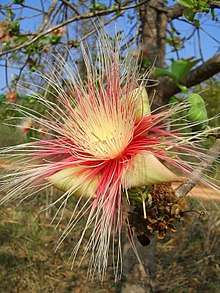Careya arborea
Careya arborea is a species of tree in the Lecythidaceae family, native to the Indian Subcontinent, Afghanistan, and Indochina.[2] It is known as Kumbhi in Hindi, and Slow Match Tree in English.

| Careya arborea | |
|---|---|
 | |
| Careya arborea[1] | |
| Scientific classification | |
| Kingdom: | |
| (unranked): | |
| (unranked): | |
| (unranked): | |
| Order: | |
| Family: | |
| Genus: | |
| Species: | C. arborea |
| Binomial name | |
| Careya arborea Roxb. | |
| Synonyms[2] | |
| |
Careya arborea is a deciduous tree that grows up to 15m-45 ft high. Its leaves turn red in the cold season. Flowers are yellow or white in colour that become large green berries. The tree grows throughout India in forests and grasslands.
Common Names[4]
- English - Wild Guava, Ceylon Oak, Patana Oak
- Hindi - कुम्भी Kumbhi
- Marathi - कुम्भा Kumbha
- Tamil - பேழை Peezhai, Aima, Karekku, Puta-tanni-maram
- Malayalam - Peelam, Pela, Paer, Alam
- Telugu - araya, budatadadimma, budatanevadi, buddaburija
- Kannada - alagavvele, daddal, Koulu mara
- Bengali - Vakamba, Kumhi, Kumbhi
- Oriya - Kumbh
- Garo - Dimbil bol
- Khasi - Ka Mahir, Soh Kundur
- Assamese - Godhajam, কুম Kum, kumari, কুম্ভী kumbhi
- Sanskrit - Bhadrendrani, गिरिकर्णिका Girikarnika, Kaidarya, कालिंदी Kalindi
- Khmer - Kandaol (កណ្ដោល)
- Sinhala - Kahata [5]
- Vietnamese - Vừng (sometimes Vừng xoan)
- Burmese - Bam-bwe (ဘန္႔ေဘြး)
- Thai - kradone (กระโดน)
Uses
In colonial times in India, the fibrous bark of this tree was found to be an ideal substitute for Beech bark as matches for matchlocks.[6]
Flowers and young leaves are eaten as salad greens in Thailand. Young fruit is reported to be edible, though seeds are slightly poisonous.[7]
fruit_in_Narsapur_forest%2C_AP_W_IMG_0148.jpg) Fruit in Narsapur, Medak district, India.
Fruit in Narsapur, Medak district, India._leaves_in_Narsapur_forest%2C_AP_W_IMG_0153.jpg) Fruit with leaves in Narsapur, Medak district, India.
Fruit with leaves in Narsapur, Medak district, India._leaves_in_Narsapur_forest%2C_AP_W_IMG_0150.jpg) Leaves in Narsapur, Medak district, India.
Leaves in Narsapur, Medak district, India._in_Narsapur_forest%2C_AP_W_IMG_0152.jpg) Trunk in Narsapur, Medak district, India.
Trunk in Narsapur, Medak district, India._caterpillar_on_Careya_arborea_W_IMG_2390.jpg)
See also
References
- 1819 illustration from Plants of the coast of Coromandel : selected from drawings and descriptions presented to the hon. court of directors of the East India Company Volume 3 of 3, by Roxburgh, William; Banks, Joseph, Sir; Mackenzie, D.; Nicol, George; Bulmer, W. Publisher: London : G. Nicol, bookseller, 1795-1819 (London : W. Bulmer).
- Kew World Checklist of Selected Plant Families
- http://www.theplantlist.org/tpl/record/kew-313601
- http://www.flowersofindia.net/catalog/slides/Wild%20Guava.html
- http://www.instituteofayurveda.org/plants/plants_detail.php?i=751&s=Family_name
- Cox, Arthur F., 1895. Madras District Manuals: North Arcot (North Arcot District Gazetteer). Madras: Government Press. p. 28. "It [Careya arborea] is useful for gun-stocks, &c.; its fibrous bark is used as matches for match-locks. The Ordnance Department, when searching for a wood suitable for fuses to be used instead of the English beech, were recommended to try this wood, and did so, pronouncing it in every way suitable for the purpose."
- http://wildedibles.teriin.org/index.php?album=Wild-edibles/Leaves/Careya-arborea
![]()
| Wikimedia Commons has media related to Careya arborea. |